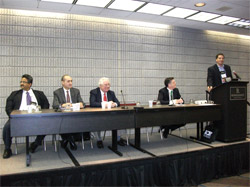
|
| Participating in a panel discussion regarding industrial refrigeration from a global perspective are, from left, P. Sudhir Kumar, Andres Valles, Klaas Visser, Guy Cloutier, and Richard Tracey. |
When refrigeration is examined from a global perspective, it is easy to discover the “haves” and the “have nots.” Developed countries like the U.S., Canada, and most European nations have refrigeration systems that protect food from its source through transportation to well-functioning and safe warehouses and distribution centers and finally to refrigerated cases before it is delivered to customers. But, in developing countries, that refrigeration aspect is often missing in most every step along the cold chain.
That concern formed the basis for much of the discussion during a panel presentation at the most recent International Institute of Ammonia Refrigeration Conference in Nashville, Tennessee.
Titled “Global View of Industrial Refrigeration,” the five panelists examined what was described as “current problems, prospects, and legal hurdles.” Along the way, attention was drawn to initiatives of IIAR and its allied associations in dealing with cold-chain developments in emerging markets.
Challenges
Richard Tracey of the Global Cold Chain Alliance drew attention to small charge ammonia refrigeration systems being developed that can be used as mobile chillers at harvest sites, an important aspect to preserve food close to the source.
But it goes beyond that, he said, because “transportation is the weakest link, especially in developing countries.” He noted instances of “no refrigeration in trucks, just pass-through cooling.” In terms of warehousing, he said, “I still see open boxes that we had in the 40°s and 50°s,” or “small little plug and plays that are having issues maintaining temperature.”
Alliances
Klaas Visser, of KAV Consulting, encouraged the formation of a global natural refrigeration alliance to monitor and respond to ongoing developments, such as a potential HFC phasedown, politically fueled statements such as Secretary of State John Kerry’s recent comment that climate change was “a weapon of mass destruction,” and shifting positions in Australia over carbon tax.
The focus, he said, should be on a move to natural refrigerants like ammonia, hydrocarbons (HCs), and CO?. “That’s our job. That is what we need to do collectively.”
China
Guy Cloutier, chairman and CEO of the CTC Holdings, encouraged continued attention on China, a country, he said, “of paradoxes where, despite big cities, is far behind in keeping up with advances in the cold chain.” He said there is “much potential for ammonia and natural refrigerants.” He did note “the cold-chain logistics started in China in 2010 and have been growing rapidly. But it is just at the beginning.
“China was facing a food safety crisis. People just don’t trust the local food. People eat McDonald’s and KFC in China not because they like it, but because it is safe food. China is in a rush to improve the infrastructure of its cold chain. When people question the safety of the infrastructure, it reflects badly on the ammonia refrigeration industry,” said Cloutier.
India
P. Sudhir Kumar of the Association of Ammonia Refrigeration (AAR) talked about the situation in India. While issues related to safety and proper operation of equipment, the challenges include a lack of specialized factory inspectors and outdated standards. Another challenge is natural refrigerants, like ammonia, gaining a greater foothold in a country that relies mainly on synthetic refrigerants. “We natural gas advocates are ants, and they, the f-gas users, are elephants.” He even noted that in one state in India, there is a requirement to change out a system from ammonia to hydrochlorofluorocarbon (HCFC)-22.
He said AAR is working to improve all aspects of refrigeration in India with a special focus on the training needs.
Latin America
The Latin American perspective was given by Andres Valles of Parker Hannifin Corp. He noted the large size of cities through that part of the world, such as Mexico City, Buenos Aires, Argentina; Rio de Janiero; Sao Paulo; Lima, Peru; and Santiago, Chile.
Throughout those cities and countries, there is a sense, he said, of engagement in refrigeration developments. “They like to say, ‘I belong in the sandbox’” in terms of being global players. He noted the ability in that part of the world “to ship finished goods and not just raw goods. There is an upward trend among the middle class, and (refrigeration) plants are getting larger. Demand for quality (products) and availability is rising.”
But, he said, “With industrial refrigeration, growth is outpacing trained/certified workers and schools with specific industrial refrigeration curriculums.” He did note that, in larger economies, there are industry-specific curricula around food processing and refrigeration.” He also noted manufacturing capability in Latin America to makes vessels, such as evaporators, condensers, control panels, and flow control devices. “But, quality varies,” he said, as with a “state-of-the-art (manufacturing) facility next to a shop with somebody making cheaper (inferior) parts.”
In calling for continued involvement of the IIAR in Latin America, he drew attention to end users, such as those in the supermarket sector, in terms of desires and safety. “Mom and pop (small grocers) shops want to grow larger, and they want to sleep well at night.”
Publication date: 7/7/2014
Want more HVAC industry news and information? Join The NEWS on Facebook, Twitter, and LinkedIn today!










